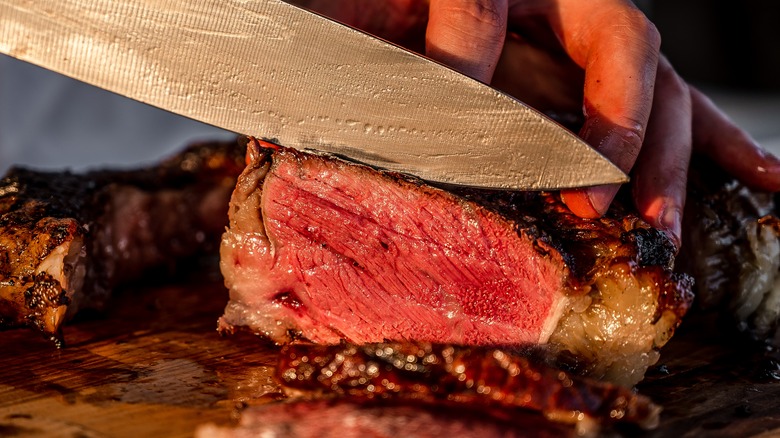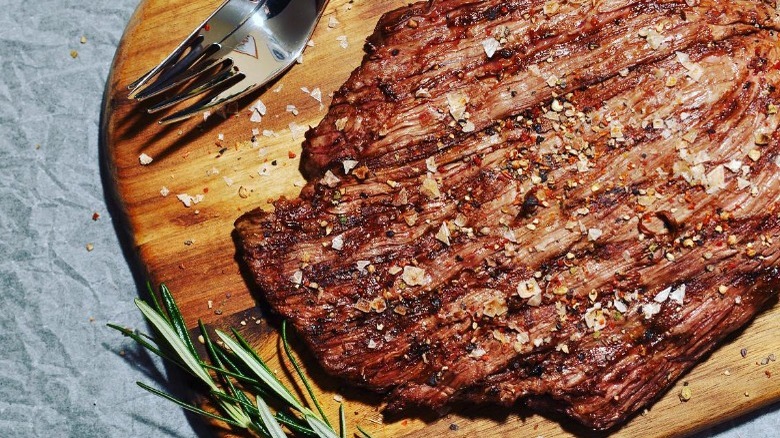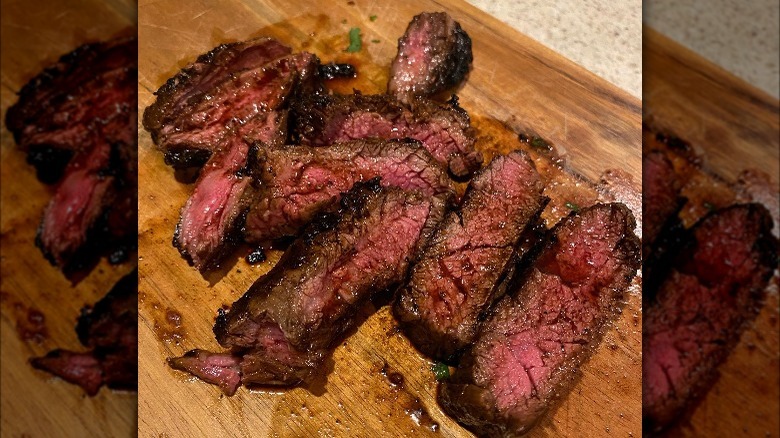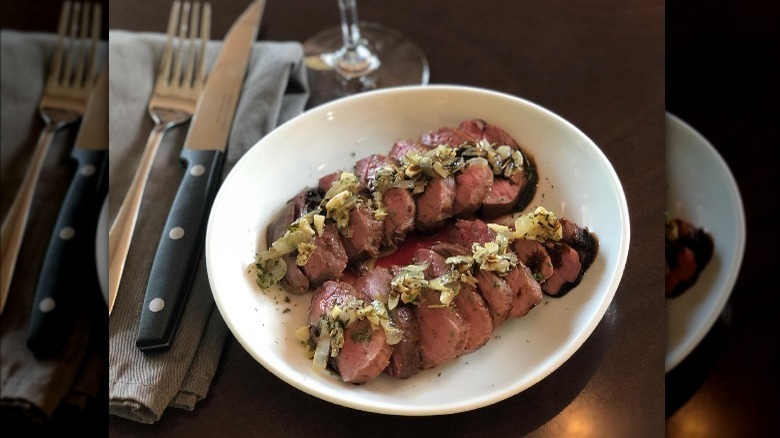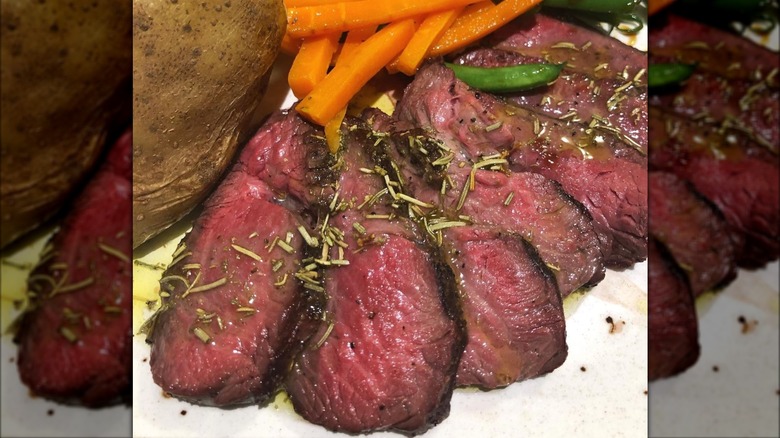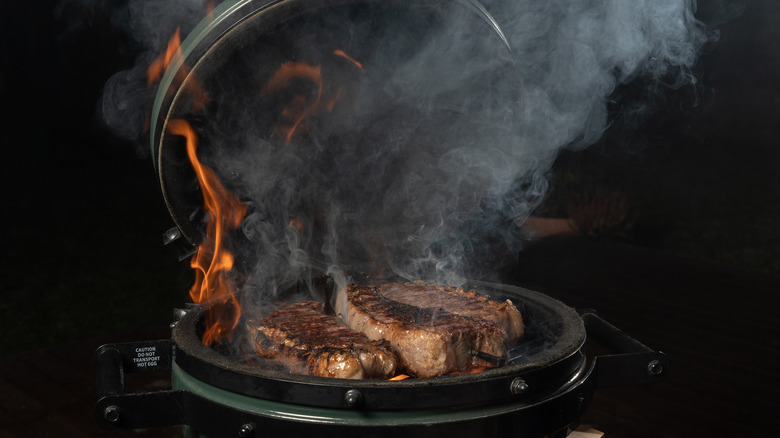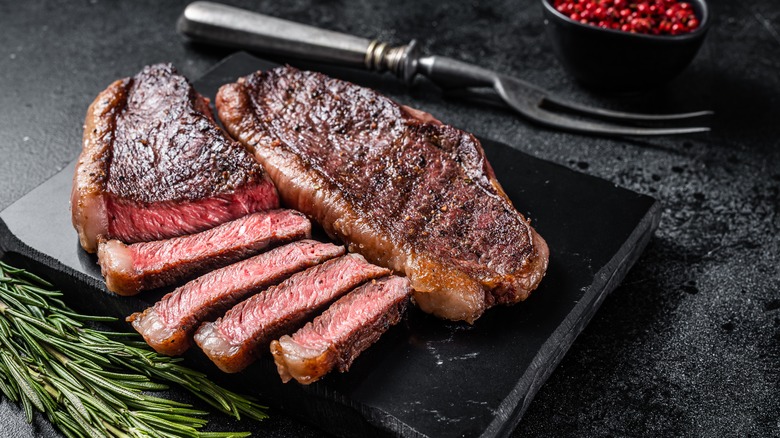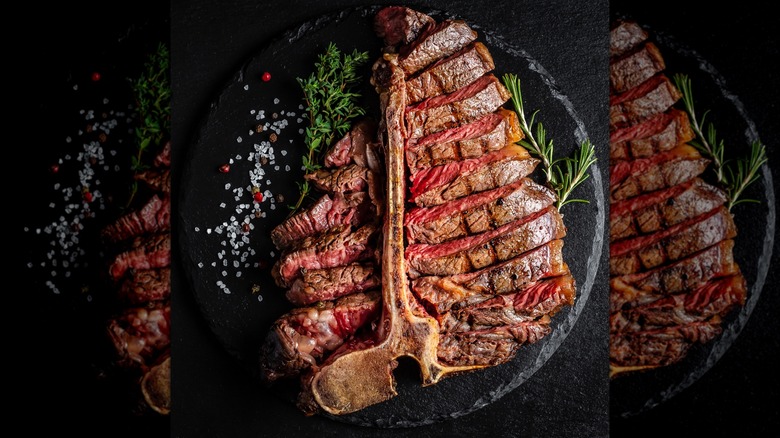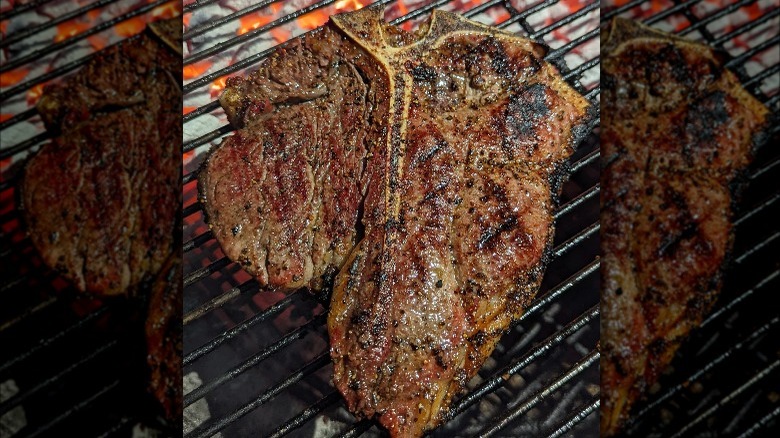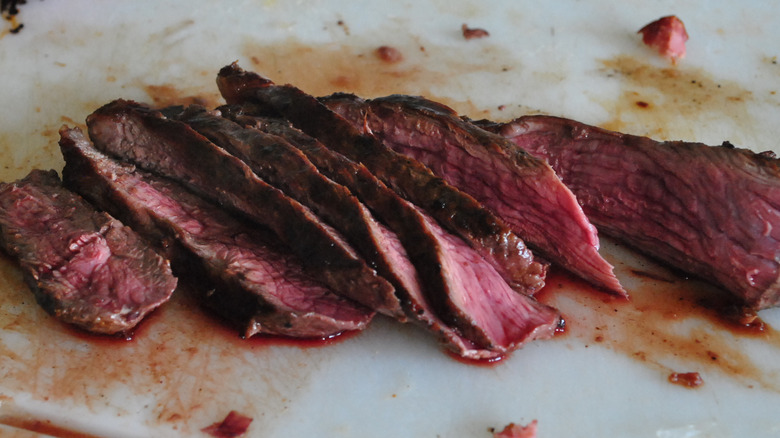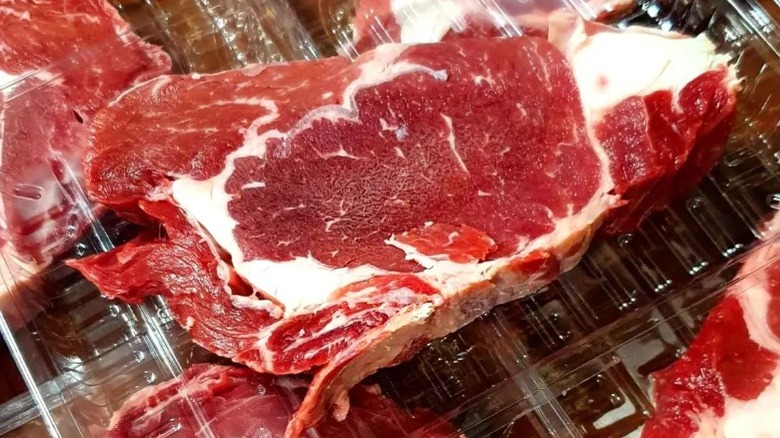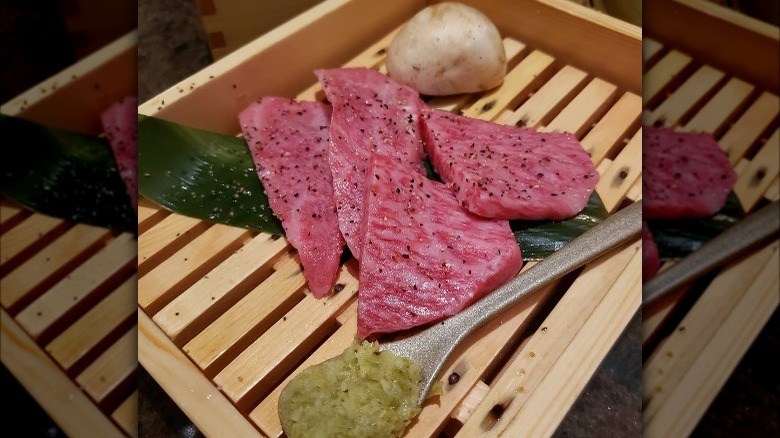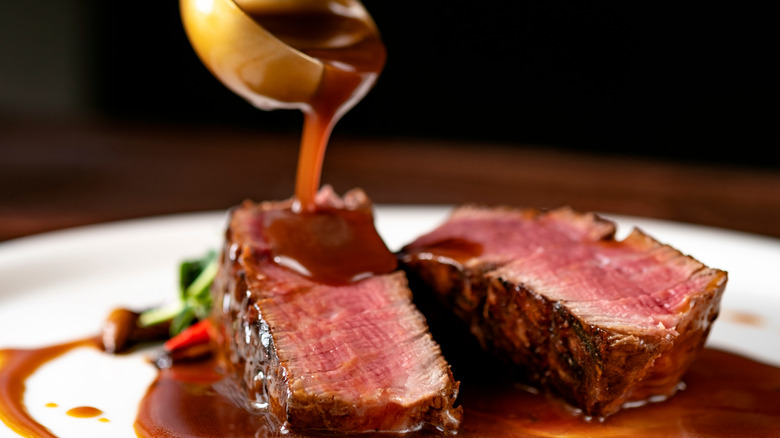Ranking Cuts Of Steak By Tenderness, From Toughest To Most Tender
Steak has almost always had a place at the American table, whether it's on the menu at diners or Michelin-starred restaurants. Even at home, steak is often served with real fanfare. So, what keeps us collectively picking up the steak knife again and again?
Well, most would define a great steak and love affair along the same lines: tenderness. Who doesn't like a cut of beef so incredibly soft that it melts in the mouth? While it might seem the most obvious that the longer a steak is cooked, the less tender and more chewy it becomes, the cut of beef is just as important as its preparation. Some muscles of the cow are simply going to be tougher, while others are more tender.
As Martha Stewart points out, muscles that are used more, like those in the cow's legs, contain more collagen. The more collagen a muscle has, the tougher its texture. A cow's back muscles, which are among the least-used, will be the most tender. Yet some cuts can be tenderized, others are less tender but deeply flavorful, and some of the tenderest muscles are the most obscure. With those complications in mind, here are some of the more common cuts of steak, ranked from the toughest to most tender.
Flank
Flank steak, original the cut used for London broil (which now utilizes a number of different cuts), is derived from the cow's abdominal muscle (via Crowd Cow). According to FoodFireFriends, this cut is one of the toughest, as the cow's abs get a lot of use when the animal grazes. But if flank steak was good enough to become synonymous with the cosmopolitan London, there's certainly something worth looking into here. When selecting a raw flank steak, make sure it's a deep red with absolutely no discoloration, as this indicates too much air exposure (via FoodFireFriends). Good cuts should have lots of muscle and little fat, though you can always trim off extra fat as desired.
There are a few ways to bring out the best in flank steak. The first is to grill quickly at a high temperature, or with an "afterburner" effect. Don't cook past medium-rare, however, as it gets very chewy fast. Marinating also helps lend flavor and texture, as per FoodFireFriends. The second way to make this cut mouthwatering is to use a slow braising technique. Note, however, that a long marinade or slow braise will most likely prevent the steak from developing a crunchy exterior. Braising might also make this cut more chewy. All told, flank turns tough easily and isn't ideal for the newbie steak chef.
Skirt steak
Skirt steak is another cut of steak from the cow's abdominal region. However, the meat that becomes skirt steak is much larger and flatter than the flank (via Crowd Cow). This cut comes from right under the rib, and is considerably fatty in comparison (via Beef). Surprisingly enough, skirt steak is often not served as a steak. Instead, it's long been the meat of choice for fajitas and stir fries. Its popularity is understandable given the steak's bold flavor.
But the fact remains that this is still a pretty tough cut of steak to manage. For those who want to give it a swing, there are a few ways to appraoch this tougher crow. Skirt steak has what Crowd Cow calls a "looser" structure and thus takes to marinating well. This will help break down the cut's structure and push it towards a more tender chew. Another means of softening up the skirt steak is by searing it at a high temperature quickly. This will help to cook the steak with less risk of it becoming tough.
Eye of round
Eye of round is an inexpensive cut from the hinter quarters, or "round" part of the cow. According to Beef, this area is used often by the cow, so the eye of round is not especially tender right out of the gate. More often than not, this cut is sold as a roast. But as FoodFireFriends argues, those who exclusively use this cut for roasts or stews are simply missing out on this underutilized form of steak with decent flavor.
FoodFireFriends warns that grilling will only make this lean cut even more tough. In fact, when cooked poorly, the steak will be both chewy and flavorless. To avoid this sad state of affairs, work to marinate the steak, which will both loosen up its structure and give it a distinct flavor. With little fat and at a great price, for those who are health and financially conscious, this cut is perfect. All that remains is the know-how of how to bring out the best in this variety of steak.
Sirloin tip side
Also known as the knuckle sirloin tip, sirloin tip side is sourced directly from the cow's quad, which does a lot of work and makes this cut tough (via Traeger). It's this toughness that the American Foods Group cites as the reason for sirloin's typically low price. While this cut is often used for roasts or ground beef, it's also possible to marinate and turn it into a more tender steak. For those on a budget, this might be a perfect compromise.
It does take caution and patience to work with this cut of steak, however. Traeger suggests marinating it for at least an hour, then only cooking the steak to medium rare. Another option is to braise the otherwise chewy cut. Sirloin cuts are also incredibly lean and, as described by ChefSteps, have all excess fat trimmed off. With some experimentation in the kitchen, it could make for a slightly indulgent twist to the otherwise bland hamburger night. But, as Traeger advises, cuts over $8 a pound are generally not worth it.
New York and Kansas City strip steak
While New York and Kansas might as well be in different universes, New York and Kansas City strip steak have a lot more in common. Both take a juicy cut in the area between the ribs and flank, better known as the short loin (via DifferenceBetween.net). The site notes that there's only really a small difference between the two cuts: the New York strip tends to be a bit bigger. Hey, when in New York, right?
Omaha Steaks notes that this is a bold slab of meat. Flavorwise, New York strip is in the big leagues, thanks to its rich fat marbling. This is nonetheless, a solid cut of steak with real meat to go along with that fat. For those who like it slightly firm, look no further.
For those who prefer a little tenderness, New York strips that are aged up to 28 days will be more tender than those that aren't. Dry-aging, which lasts up to 60 days, will contribute to this cut's bold nature while adding a new layer of melt-in-your-mouth texture (via Omaha Steak). When cooking, more seasoned chefs should consider buying a strip steak with the bone still in. As per Omaha Steaks, this will help the cut retain its juiciness and tenderness while cooking. The only issue is that it is a bit trickier to heat evenly, so approach with caution.
Top sirloin
Sirloin steak might be well-known, but you probably didn't know that sirloin can be divided into two groups: top and bottom sirloin butt (via Beef). The biggest difference between the two is the cooking method that brings out the best in each. Top sirloin is a bit more tender than bottom and should be grilled. Omaha Steaks describes this cut as lean and chock-full of flavor. While it's not the most marbled cut of steak, Omaha Steaks argues that some diners actually prefer a firmer chew. Anyway, lean doesn't immediately equal tough, with enough care during the cooking process. Furthermore, top sirloin is an inexpensive option that can dress up a weeknight dinner and is well-suited to diets like paleo or keto.
For those who like the price point but are less drawn to the texture, Omaha Steaks recommends looking into aged cuts. The aging process softens up top sirloin; anywhere up to 28 days will provide a more tender bite. Finally, marinades and rubs can add some extreme flavor to this beefy classic.
T-bone
It doesn't take much imagination to understand where the T-bone's name comes from. Beef credits the moniker to the T-shaped bone that divides this cut of steak. The bone quite literally divides the cut into two cuts: the strip and tenderloin (via Livestrong). In comparison to the similar strip steak and tenderloin, the T-bone is a leaner cut of meat. But, don't shy away from this particular type of steak, as methods like broiling and grilling make this cut shine.
That said, there are a few things to bear in mind when standing guard at the grill. Livestrong notes that marinating this steak will only take you so far, as it's the grilling that determines just how tender this cut is going to be. Consider taking the steak out only 30 minutes before cooking to preserve its tenderness. Meanwhile, although steak marinades will tenderize the meat, it's typically only on a surface level. Livestrong recommends incorporating papaya or pineapple into the marinade instead of lemon or vinegar, as the tropical fruits have special enzymes that will help tenderize the steak completely. Just remember that these marinades tend to work more quickly, and so only let the steak sit for 15 minutes before cooking.
Porterhouse
The porterhouse cut is taken from the loin portion of the cow's back and is naturally very tender with little additional work (via Crowd Cow). The porterhouse is a giant among steaks, and beloved by many. Despite this popularity, there remains much confusion as to what differentiates a porterhouse from a T-bone. A porterhouse is even similarly cut between two sections: short loin and tenderloin. But, as per FoodFireFriends, porterhouse has a markedly larger portion of tenderloin, the more tender half of the T-bone. Porterhouse steaks contain, on average, about 2.5 times more tenderloin than T-bones. This, understandably, gives the impression that the porterhouse has more bang for its buck, at least when it comes to tenderness.
This steak really does try to have the best of both worlds. FoodFireFriends notes that the short loin portion has plenty of flavorful fat, while the tenderloin half is characteristically mild, but with that dreamy melt-in-your-mouth effect. Although porterhouse is primarily served at steakhouses, it can also be found at specialty butchers and high-end grocery stores. All told, finding the steak should be the hardest part of the journey. They are typically sold pre-trimmed and do not need much preparation beyond seasoning. The flavor is otherwise best left untouched.
Picanha
In the famed South Ameircan home of the steak, picanha is what experts like those at the Steak School call the "queen" of the steak cuts. Picanha's name means "rump cap," which perfectly describes where this meat is sourced from. Of course, the cow's rump doesn't do a lot of work, which translates to an especially tender cut of beef covered with a substantial amount of fat. The cut's unofficial royal title is well-earned.
Picanha is a triangular cut that gets all the more tender as the eater reaches the tip. Picanha hasn't yet made it to the mainstream in the U.S., and those who want to try this cut out should probably head over to their local butcher or Brazilian steakhouse. Steak School notes there are a few things to look out for, however. For one, this steak cut should never be big. Each cut should weigh between 1 to 1.5kg, without going over. The cut should also have a large fat cap with no liquid on top. Once in the kitchen, there's not much to do besides cut off the skin while retaining the fat, and perhaps seasoning the steak with a bit of salt.
Ribeye
As one might be able to guess from the name, ribeye steaks are sourced from the cow's rib (via Crowd Cow). As Beef points out, the rib muscle does very little work for bovines. This results in a cut of steak that does just as well on the dinner table at home as it does in a fancy steakhouse. Ribeye steaks are smaller than other cuts, and according to Crowd Cow, weigh in at around 4 ounces at the most. But this small cut carries a serious punch. Unlike other tender cuts of steak, ribeyes are richly marbled with tantalizing bits of fat. Thus, it's can produce a magical combination of tender, flavorful, and juicy.
For those who are more skittish about cooking rare steak, ribeye is a good cut. With such a high fat content, Crowd Cow notes that this cut can be cooked up to medium while still maintaining its robust flavor and characteristic tenderness. Meanwhile, flavorful sauces don't overwhelm this treasure. But why gild the lily? This already flavorful steak will do just fine with a simple seasoning of salt and freshly cracked pepper.
Ribeye cap
Ribeye cap is heralded by Serious Eats as the mouthwatering meeting point between the super-tender tenderloin and the mega-tasty ribeye. It's one of the choicest of choice cuts. This cap can also be as calotte or deckle steak, but is otherwise simply unmistakable. Snake River Farms clarifies that, as the name implies, the ribeye cap is the small, outermost edge of the ribeye steak. When isolated, cut, and grilled by itself, it stands out as a tantalizing trifecta of texture, taste, and spectacular juiciness. Whatever sort of steak craving you may be experiencing, the ribeye cap is sure to satisfy them all.
The ribeye cap is best grilled at high temperatures in order to preserve all of its best qualities. Luxury does come at a price however, and so you'd better prepare you wallet. These cuts typically come in at $99 a pop (via Serious Eats). For those who are looking for steaks that are both tender and flavorful, though, that may just be a price worth paying. What's more, you should know that ,with this cut, a little bit goes a long way. Ribeye cap is so rich that it can easily feed two hungry steak lovers wanting to get a piece of this tender, tasty action.
Filet mignon
It's safe to say that filet mignon is a staple of steakhouses everywhere. But what stop there? Omaha Steaks advises us to look past the high-class dressings and acknowledge this is simply a supreme slice of steak. Filet mignons are cut solely from tenderloin, an exceptionally melt-in-your-mouth part of the cow. This muscle bears absolutely no weight, ergo it's about the least lean cut of meat around. The filet mignon, unlike other steak cuts, is solely sourced from the tenderloin, which only accounts for 2 to 3% of the entire cow's body (via Omaha Steaks). This is not only what makes this cut tender, but also seriously drives up its price. When cooked correctly, filet mignon is so tender that a steak knife is not necessary to enjoy it.
Despite the high-class reputation, there's no need to feel any sort of fear when tackling this cut at home. As Better Homes & Gardens assures everyone, the undertaking isn't as complicated as it may first seem. In fact, simplicity key. Filet mignon does not need to be simmered, stewed, or braised. These mild-flavored steaks do best in a quick heat, preferably by grilling, pan-frying, or broiling. For those who would like a little more flavor, Omaha Steaks notes that this filet mignons take well to additions such as marinades, rubs, and seasoning. Yet, while these are sure to add another layer to this tender beauty, we urge you to at least try filet mignon in its unadulterated glory.
